A Novel 4H-SiC SGT MOSFET with Improved P+ Shielding Region and Integrated Schottky Barrier Diode
Abstract
:1. Introduction
2. Device Structure and Characteristics
3. Results and Discussion
4. Conclusions
Author Contributions
Funding
Data Availability Statement
Conflicts of Interest
References
- She, X.; Huang, A.Q.; Lucia, O.; Ozpineci, B. Review of silicon carbide power devices and their applications. IEEE Trans. Ind. Electron. 2017, 64, 8193–8205. [Google Scholar] [CrossRef]
- Zhang, L.; Ma, J.; Cui, Y.; Cui, W.; Yuan, S.; Zhu, J.; He, N.; Zhang, S.; Sun, W. Simulation Study of A 1200V 4H-SiC Lateral MOSFET With Reduced Saturation Current. IEEE Electron Device Lett. 2021, 42, 1037–1040. [Google Scholar] [CrossRef]
- Sun, P.; Zou, M.; Wang, Y.; Gong, J.; Liang, Y.; Niu, F.; Jiang, K.; Gao, W.; Zeng, Z. Focuses and Concerns of Dynamic Test for Wide Bandgap Device: A Questionnaire-Based Survey. IEEE Trans. Power Electron. 2023, 38, 15522–15534. [Google Scholar] [CrossRef]
- Yao, K.; Yano, H.; Tadano, H.; Iwamuro, N. Investigations of SiC MOSFET Short-Circuit Failure Mechanisms Using Electrical, Thermal, and Mechanical Stress Analyses. IEEE Trans. Electron Devices 2020, 67, 4328–4334. [Google Scholar] [CrossRef]
- Yu, Y.; Liu, T.; Ma, R.; Cheng, Z.; Tao, J.; Guo, J.; Wu, H.; Hu, S. A Novel Asymmetric Trench SiC MOSFET With an Integrated JFET for Improved Reverse Conduction Performance. IEEE Trans. Electron Devices 2024, 71, 1546–1552. [Google Scholar] [CrossRef]
- Ju, X.; Cheng, Y.; Yang, M.; Cui, S.; Sun, A.; Liu, X.; He, M. Voltage Stress Calculation and Measurement for Hairpin Winding of EV Traction Machines Driven by SiC MOSFET. IEEE Trans. Ind. Electron. 2022, 69, 8803–8814. [Google Scholar] [CrossRef]
- Han, Z.; Bai, Y.; Chen, H.; Li, C.; Lu, J.; Yang, C.; Yao, Y.; Tian, X.; Tang, Y.; Song, G.; et al. A Novel 4H-SiC Trench MOSFET Integrated with Mesa-Sidewall SBD. IEEE Trans. Electron Devices 2021, 68, 192–196. [Google Scholar] [CrossRef]
- Nguyen, T.-T.; Ahmed, A.; Thang, T.V.; Park, J.-H. Gate Oxide Reliability Issues of SiC MOSFETs Under Short-Circuit Operation. IEEE Trans. Power Electron. 2015, 30, 2445–2455. [Google Scholar] [CrossRef]
- Pu, S.; Akin, B.; Yang, F. Active Channel Impact on SiC MOSFET Gate Oxide Reliability. In Proceedings of the 2021 IEEE Applied Power Electronics Conference and Exposition (APEC), Phoenix, AZ, USA, 14–17 June 2021; pp. 1250–1255. [Google Scholar] [CrossRef]
- Kim, D.; DeBoer, S.; Jang, S.Y.; Morgan, A.J.; Sung, W. Improved Blocking and Switching Characteristics of Split-Gate 1.2 kV 4H-SiC MOSFET with a Deep P-well. In Proceedings of the 2023 35th International Symposium on Power Semiconductor Devices and ICs (ISPSD), Hong Kong, 28 May–1 June 2023; pp. 350–353. [Google Scholar] [CrossRef]
- Tan, J.; Cooper, J.; Melloch, M. High-Voltage accumulation-layer UMOSFET’s in 4H-SiC. IEEE Electron Device Lett. 1998, 19, 487–489. [Google Scholar] [CrossRef]
- Wei, J.; Wei, Z.; Fu, H.; Cao, J.; Wu, T.; Sun, J.; Zhu, X.; Li, S.; Zhang, L.; Liu, S.; et al. Review on the Reliability Mechanisms of SiC Power MOSFETs: A Comparison Between Planar-Gate and Trench-Gate Structures. IEEE Trans. Power Electron. 2023, 38, 8990–9005. [Google Scholar] [CrossRef]
- Nakamura, R.; Nakano, Y.; Aketa, M.; Noriaki, K.; Ino, K. 1200 V 4H-SiC Trench Devices. In Proceedings of the PCIM Europe 2014; International Exhibition and Conference for Power Electronics, Intelligent Motion, Renewable Energy and Energy Management, Nuremberg, Germany, 20–22 May 2014; pp. 1–7. [Google Scholar]
- Li, P.; Ma, R.; Shen, J.; Jing, L.; Guo, J.; Lin, Z.; Hu, S.; Shi, C.; Tang, F. A Novel SiC MOSFET With a Fully Depleted P-Base MOS-Channel Diode for Enhanced Third Quadrant Performance. IEEE Trans. Electron Devices 2022, 69, 4438–4443. [Google Scholar] [CrossRef]
- Roy, S.K.; Basu, K. Measurement of Circuit Parasitics of SiC MOSFET in a Half-Bridge Configuration. IEEE Trans. Power Electron. 2022, 37, 11911–11926. [Google Scholar] [CrossRef]
- Luo, X.; Liao, T.; Wei, J.; Fang, J.; Yang, F.; Zhang, B. A novel 4H-SiC trench MOSFET with double shielding structures and ultralow gate-drain charge. J. Semicond. 2019, 40, 052803. [Google Scholar] [CrossRef]
- Jiang, J.-Y.; Huang, C.-F.; Wu, T.-L.; Zhao, F. Simulation Study of 4H-SiC Trench MOSFETs with Various Gate Structures. In Proceedings of the 2019 Electron Devices Technology and Manufacturing Conference (EDTM), Singapore, 12–15 March 2019; pp. 401–403. [Google Scholar] [CrossRef]
- Matsui, K.; Aiba, R.; Yano, H.; Iwamuro, N.; Baba, M.; Harada, S. Comprehensive Study on Electrical Characteristics in 1.2 kV SiC SBD-integrated Trench and Planar MOSFETs. In Proceedings of the 2021 33rd International Symposium on Power Semiconductor Devices and ICs (ISPSD), Nagoya, Japan, 30 May–3 June 2021; pp. 215–218. [Google Scholar] [CrossRef]
- Li, X.; Tong, X.; Huang, A.Q.; Tao, H.; Zhou, K.; Jiang, Y.; Jiang, J.; Deng, X.; She, X.; Zhang, B.; et al. SiC Trench MOSFET with Integrated Self-Assembled Three-Level Protection Schottky Barrier Diode. IEEE Trans. Electron Devices 2018, 65, 347–351. [Google Scholar] [CrossRef]
- Furukawa, M.; Kono, H.; Sano, K.; Yamaguchi, M.; Suzuki, H.; Misao, T.; Tchouangue, G. Improved reliability of 1.2 kV SiC MOSFET by preventing the intrinsic body diode operation. In PCIM Europe Digital Days 2020; International Exhibition and Conference for Power Electronics, Intelligent Motion, Renewable Energy and Energy Management; VDE: Berlin, Germany, 2020; pp. 1–5. [Google Scholar]
- Yi, B.; Li, H.; Zhang, B.; Xu, Y.; Shi, W.; Xiang, Y.; Zhou, R.; Cheng, J.; Huang, H.; Kong, M.; et al. Fabricating and TCAD Optimization for a SiC Trench MOSFET With Tilted P-Shielding Implantation and Integrated TJBS. IEEE Trans. Electron Devices 2024, 71, 1618–1625. [Google Scholar] [CrossRef]
- Kitamura, Y.; Yano, H.; Iwamuro, N.; Kato, F.; Tanaka, S.; Tawara, T.; Harada, S.; Sato, H. Demonstration of the Surge Current Capability of Embedded SBDs in SiC SBD-Integrated Trench MOSFETs with a Thick Cu Block. In Proceedings of the 2022 IEEE 34th International Symposium on Power Semiconductor Devices and ICs (ISPSD), Vancouver, BC, Canada, 22–25 May 2022; pp. 109–112. [Google Scholar] [CrossRef]
- Yao, K.; Kato, F.; Tanaka, S.; Harada, S.; Sato, H.; Yano, H.; Iwamuro, N. Enhanced Short-circuit Capability for 1.2 kV SiC SBD-integrated Trench MOSFETs Using Cu Blocks Sintered on the Source Pad. In Proceedings of the 2022 IEEE 34th International Symposium on Power Semiconductor Devices and ICs (ISPSD), Vancouver, BC, Canada, 22–25 May 2022; pp. 297–300. [Google Scholar] [CrossRef]
- Ohashi, T.; Kono, H.; Kanie, S.; Ogata, T.; Sano, K.; Suzuki, H.; Asaba, S.; Fukatsu, S.; Iijima, R. Improved Clamping Capability of Parasitic Body Diode Utilizing New Equivalent Circuit Model of SBD-embedded SiC MOSFET. In Proceedings of the 2021 33rd International Symposium on Power Semiconductor Devices and ICs (ISPSD), Nagoya, Japan, 30 May–3 June 2021; pp. 79–82. [Google Scholar] [CrossRef]
- Ohashi, T.; Kono, H.; Asaba, S.; Hayakawa, H.; Ogata, T.; Iijima, R. Improvement of Surge Current Capability in SBD-embedded SiC MOSFETs by Introducing Trigger p-n Diodes. In Proceedings of the 2023 35th International Symposium on Power Semiconductor Devices and ICs (ISPSD), Hong Kong, 28 May–1 June 2023; pp. 242–245. [Google Scholar] [CrossRef]
- TCAD Sentaurus Device Manual; Synopsys: Mountain View, CA, USA, 2016.
- Basler, T.; Heer, D.; Peters, D.; Schorner, R. Practical aspects and body diode robustness of a 1200 V SiC trench MOSFET. In Proceedings of the PCIM Europe 2018; International Exhibition and Conference for Power Electronics, Intelligent Motion, Renewable Energy and Energy Management, Nuremberg, Germany, 5–7 June 2018; VDE: Berlin, Germany, 2018; Volume 18, pp. 313–315. [Google Scholar]
- Zhou, X.; Zhang, S.; Li, M.; Jia, Y.; Hu, D.; Wu, Y.; Zhao, Y. SiC Trench MOSFET with Embedded Schottky Super Barrier Rectifier for High Temperature Ruggedness. IEEE Trans. Electron Devices 2023, 70, 5786–5794. [Google Scholar] [CrossRef]
- Ou, Y.; Lan, Z.; Hu, X.; Liu, D. Novel SiC Trench MOSFET with Improved Third-Quadrant Performance and Switching Speed. Micromachines 2024, 15, 254. [Google Scholar] [CrossRef] [PubMed]
- Yu, Y.; Cheng, Z.; Hu, Y.; Lv, R.; Hu, S. A Novel Asymmetric Trench SiC Metal–Oxide–Semiconductor Field-Effect Transistor with a Poly-Si/SiC Heterojunction Diode for Optimizing Reverse Conduction Performance. Micromachines 2024, 15, 461. [Google Scholar] [CrossRef] [PubMed]
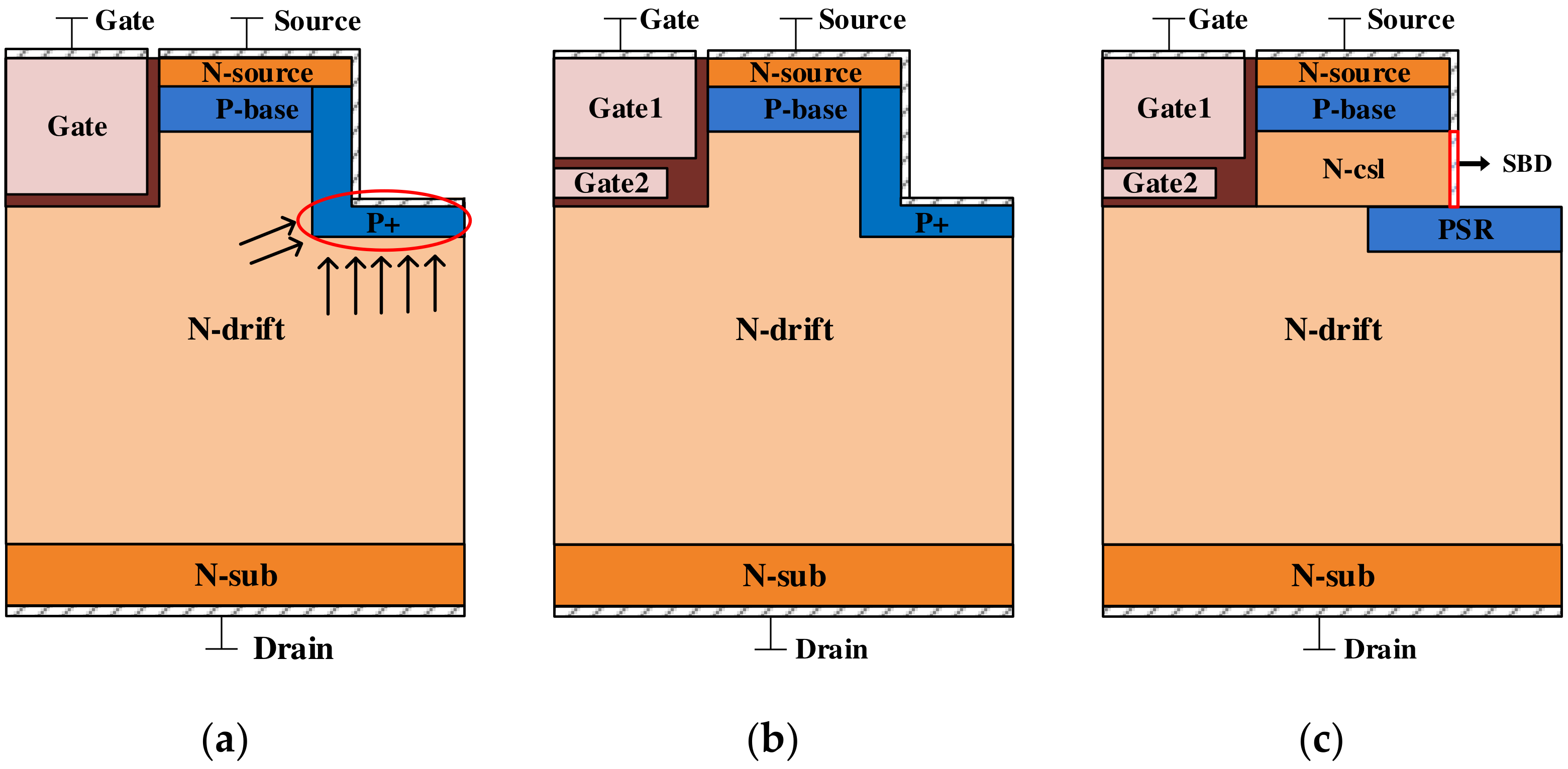

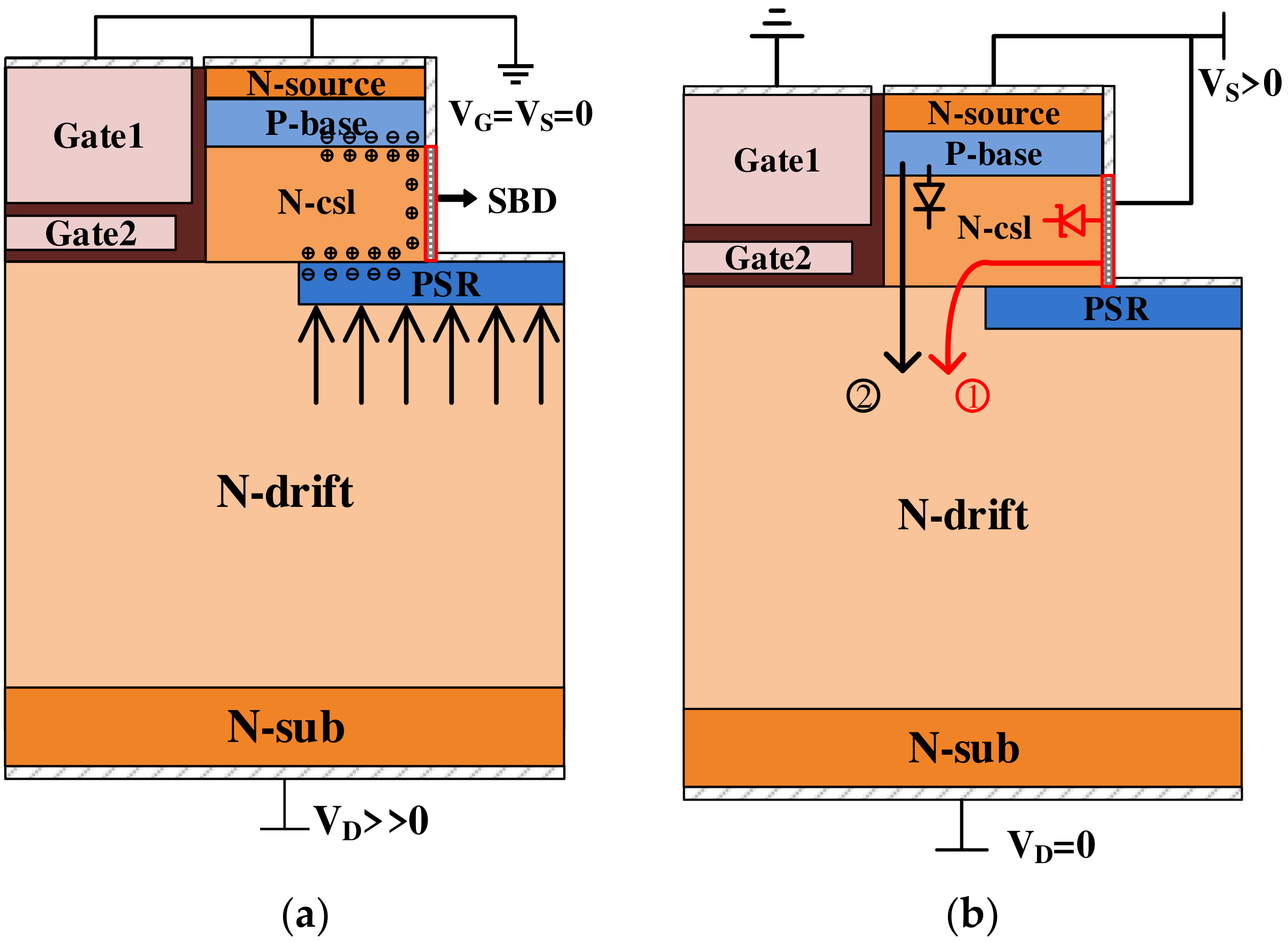
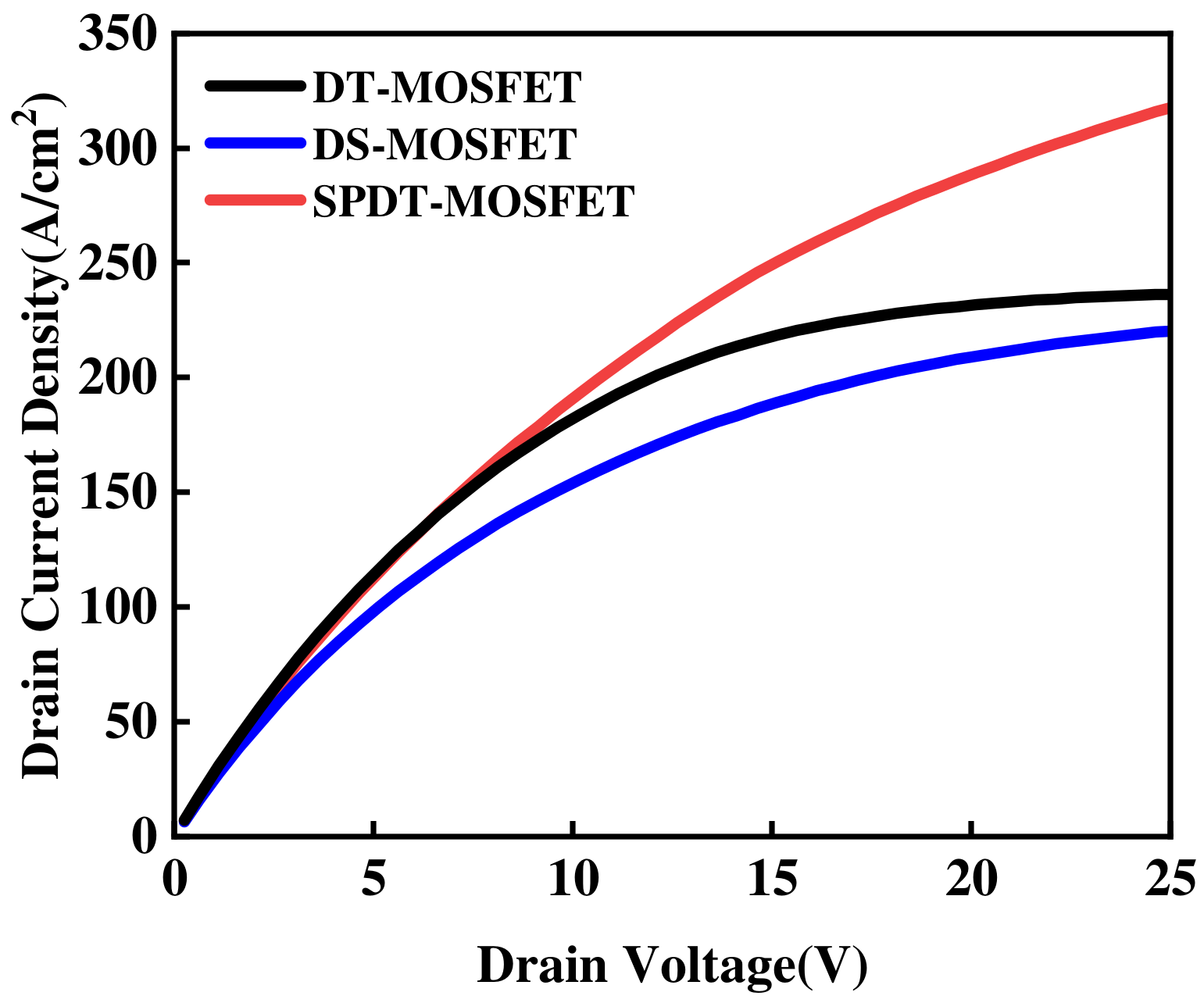

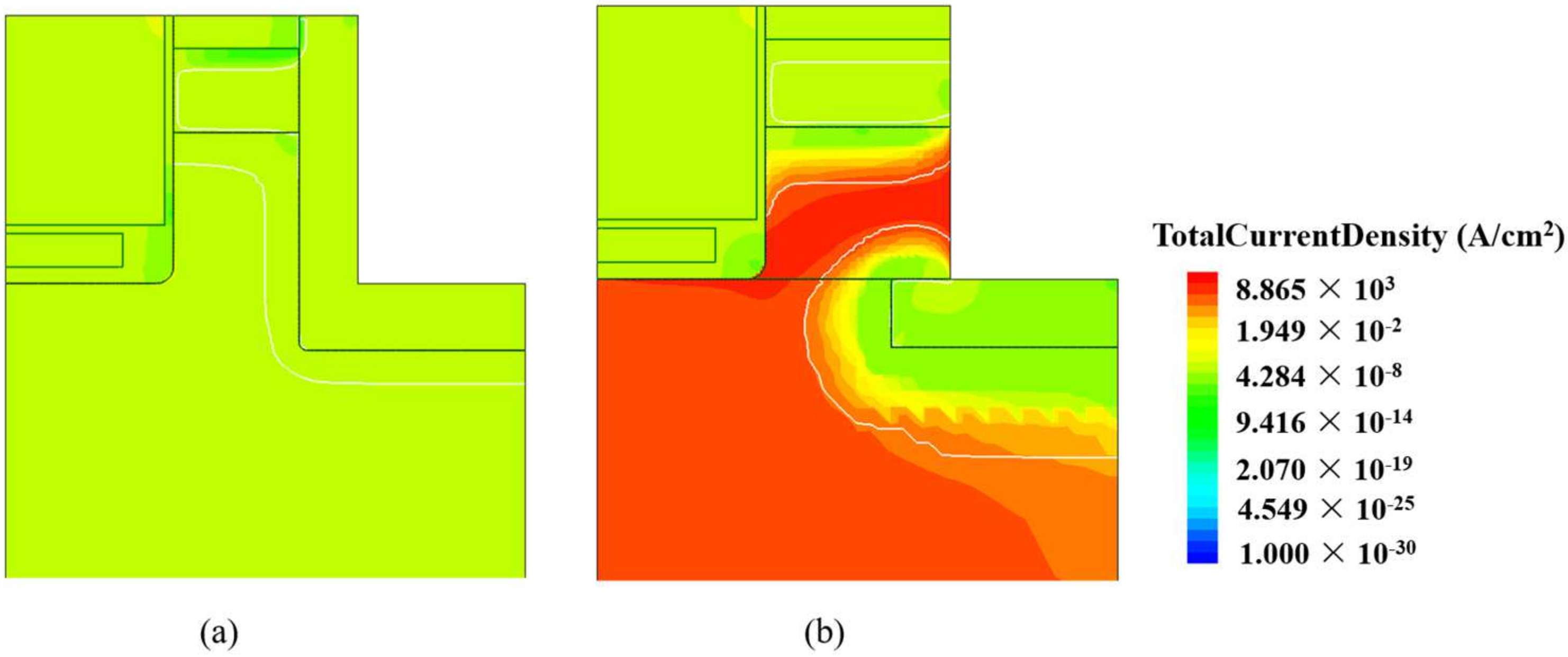
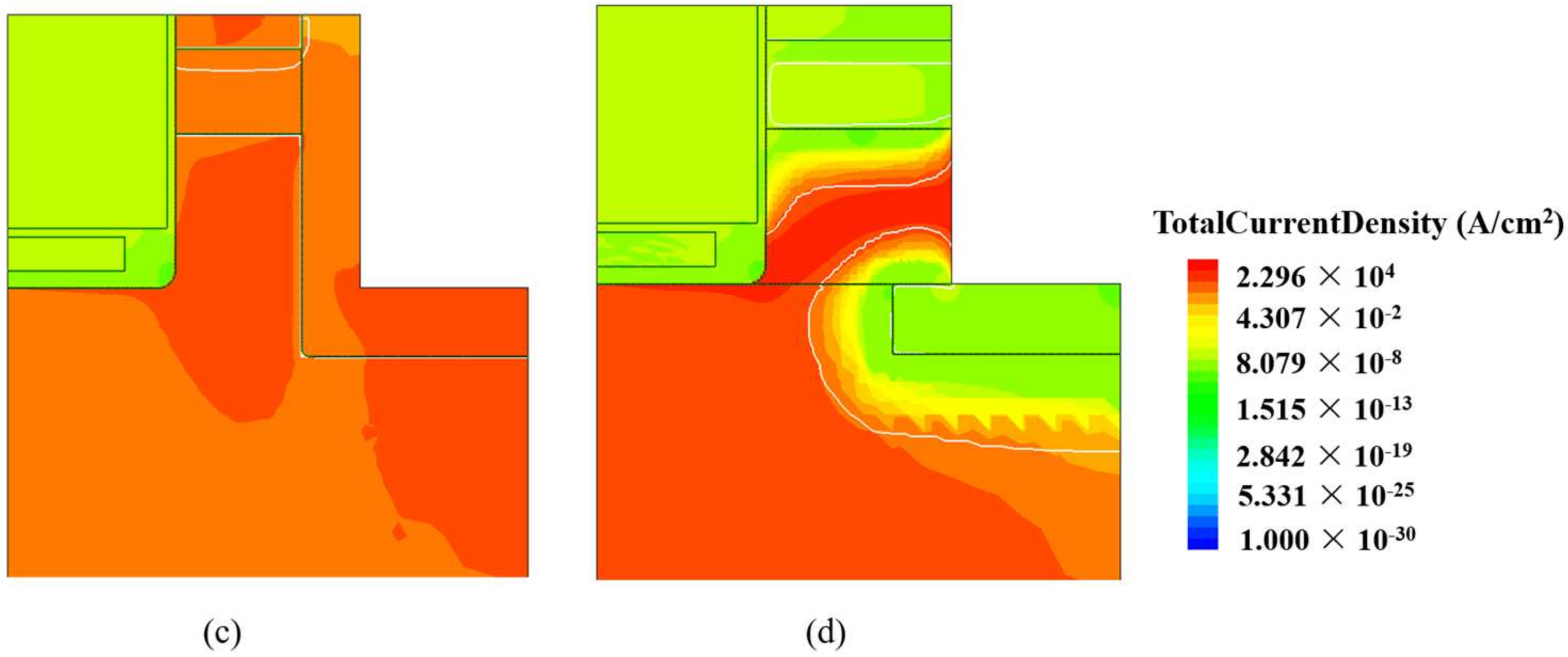


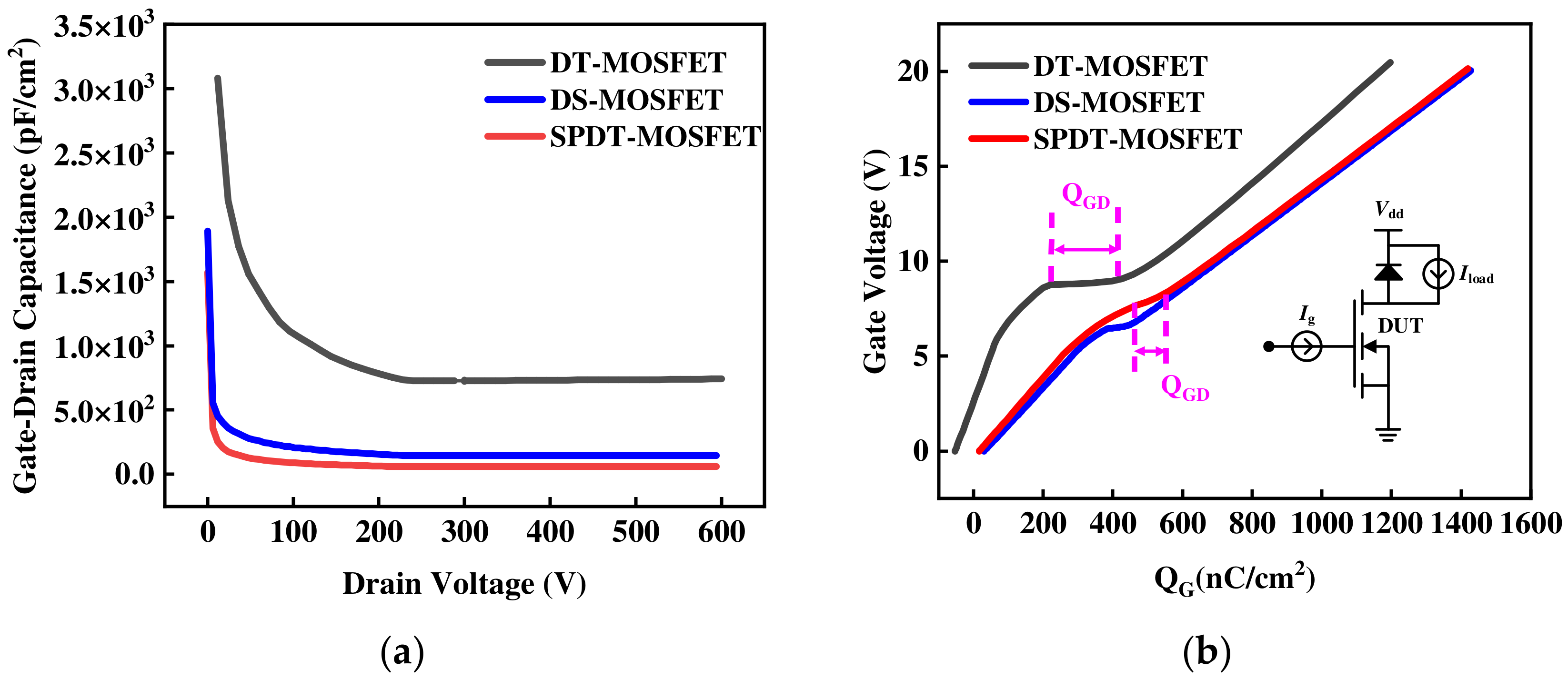
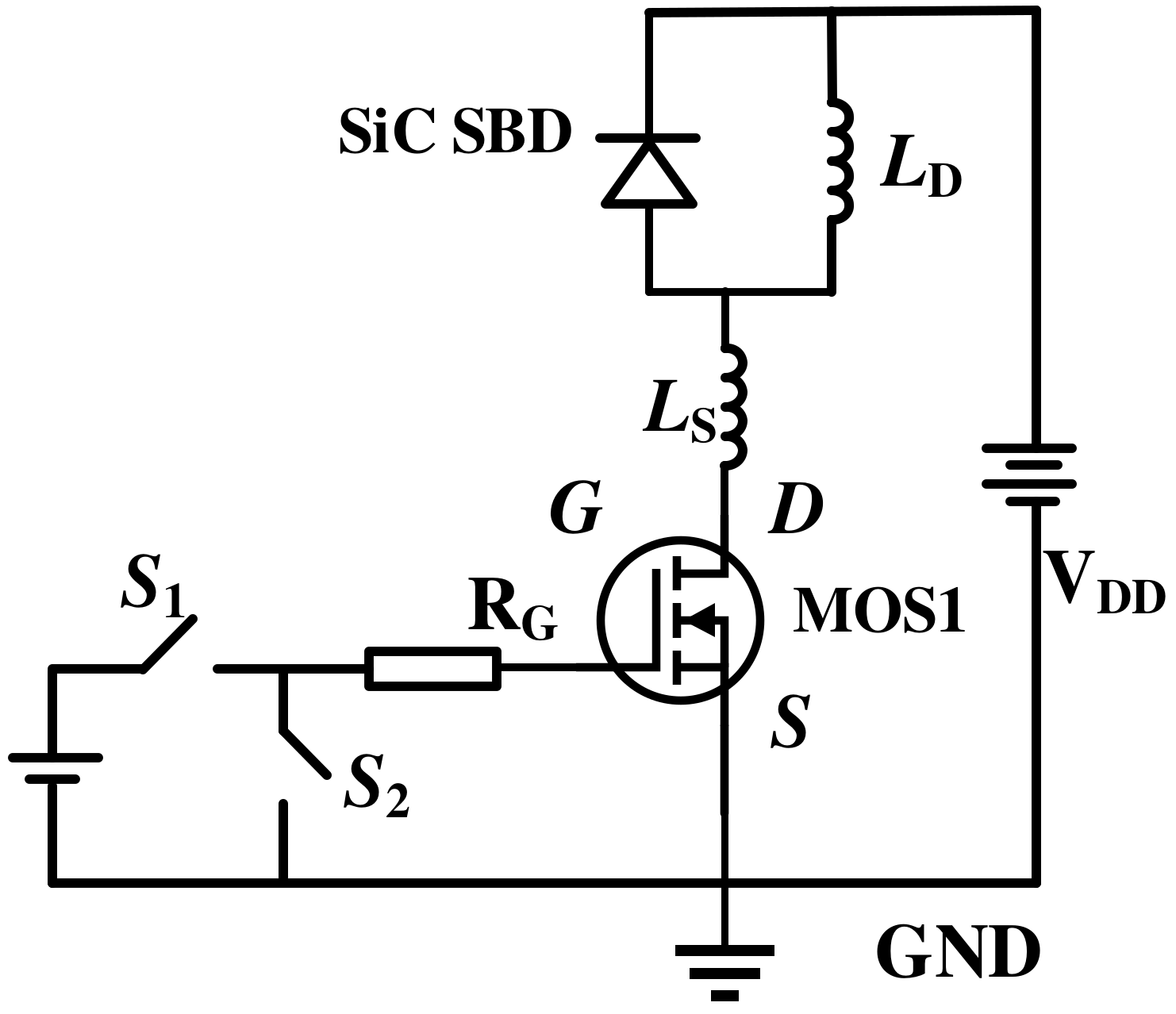
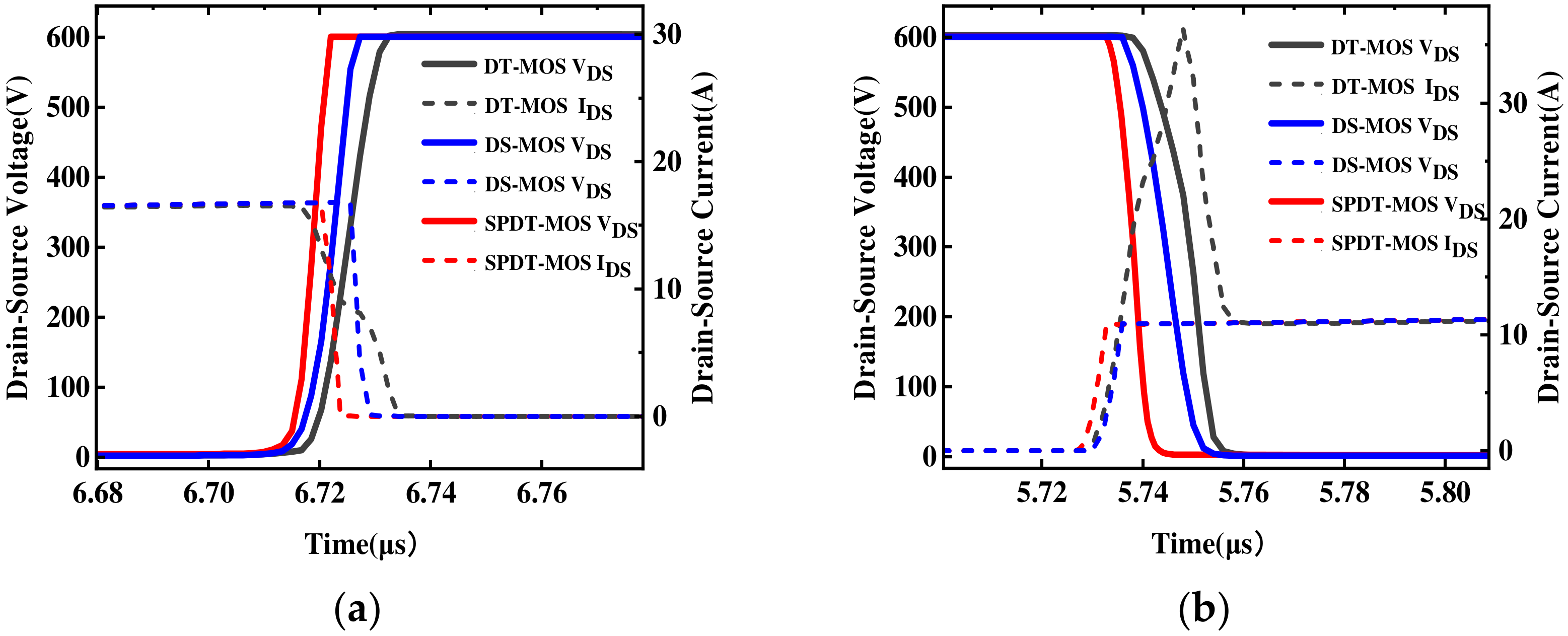

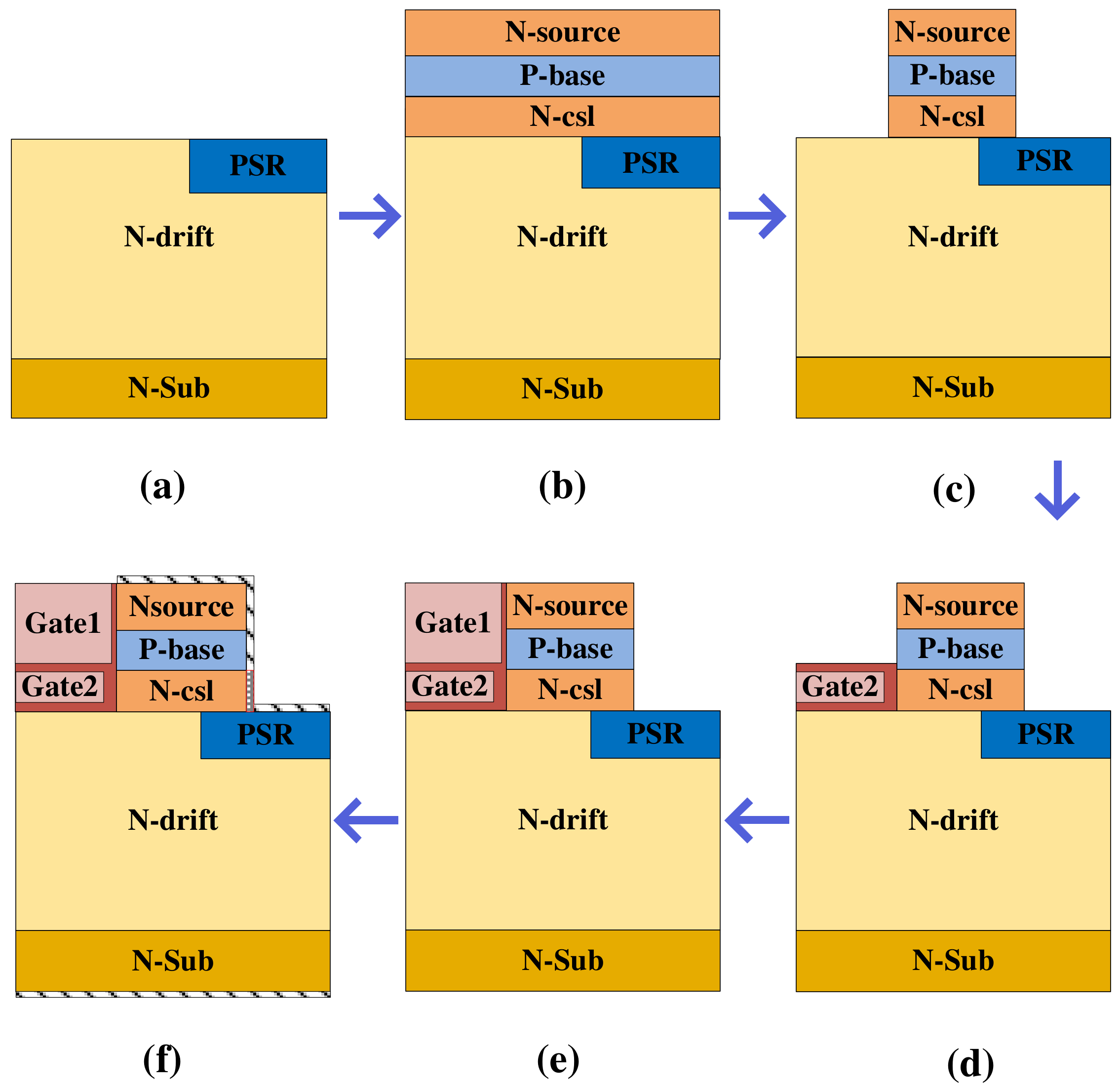
| Parameters | SPDT-MOSFET | DS-MOSFET | DT-MOSFET |
|---|---|---|---|
| Gate oxide thickness (nm) | 50 | 50 | 50 |
| Schottky contact length (μm) | 0.9 | - | - |
| Gate length (um) | 1.6 | 1.6 | 1.6 |
| P-type Stop Region doping (cm−3) | 2 × 1018 | 2 × 1018 | 2 × 1018 |
| Thickness of split gate (μm) | 0.2 | 0.2 | 0.2 |
| N-drift epitaxy doping (cm−3) | 8 × 1015 | 8 × 1015 | 8 × 1015 |
| N-drift epitaxy thickness (µm) | 11 | 11 | 11 |
| Width of half cell (µm) | 3.1 | 3.1 | 3.1 |
| Parameters | Device Type | ||
|---|---|---|---|
| SPDT-MOSFET | DS-MOSFET | DT-MOSFET | |
| VON (V) | 1.5 | 2.6 | 2.6 |
| BD | No | Yes | Yes |
| VBR2/Ron-sp * (GW/cm2) | 0.85 | 0.42 | 0.74 |
| (MV/cm) | 1.5 | 4.8 | 4.28 |
| (nC/cm2) | 115 | 163 | 195 |
| (pF/cm2) (@VDS = 600 V) | 140 | 144 | 746 |
| HF-FOM (mΩ·nC) | 276 | 684.6 | 546 |
| (mJ/cm2) | 4.68/0.25 | 4.61/1.40 | 7.1/0.42 |
| (nC/cm2) | 29.85 | 501.79 | 332.45 |
Disclaimer/Publisher’s Note: The statements, opinions and data contained in all publications are solely those of the individual author(s) and contributor(s) and not of MDPI and/or the editor(s). MDPI and/or the editor(s) disclaim responsibility for any injury to people or property resulting from any ideas, methods, instructions or products referred to in the content. |
© 2024 by the authors. Licensee MDPI, Basel, Switzerland. This article is an open access article distributed under the terms and conditions of the Creative Commons Attribution (CC BY) license (https://creativecommons.org/licenses/by/4.0/).
Share and Cite
Cao, X.; Liu, J.; An, Y.; Ren, X.; Yin, Z. A Novel 4H-SiC SGT MOSFET with Improved P+ Shielding Region and Integrated Schottky Barrier Diode. Micromachines 2024, 15, 933. https://doi.org/10.3390/mi15070933
Cao X, Liu J, An Y, Ren X, Yin Z. A Novel 4H-SiC SGT MOSFET with Improved P+ Shielding Region and Integrated Schottky Barrier Diode. Micromachines. 2024; 15(7):933. https://doi.org/10.3390/mi15070933
Chicago/Turabian StyleCao, Xiaobo, Jing Liu, Yingnan An, Xing Ren, and Zhonggang Yin. 2024. "A Novel 4H-SiC SGT MOSFET with Improved P+ Shielding Region and Integrated Schottky Barrier Diode" Micromachines 15, no. 7: 933. https://doi.org/10.3390/mi15070933






